Welcome to Sandy Bridge, with the ASRock P67 Extreme4
by Ian Cutress on January 3, 2011 7:00 AM EST- Posted in
- Motherboards
- ASRock
System Benchmarks
CrystalDiskMark 3.0.1
We test the motherboard's USB 2.0 and USB 3.0 speed via CrystalDiskMark. We run the sequential test to find the optimum read/write speed, then perform a copy from the SSD to the USB device. We copy a set of 2867 files across 320 folders—95% of these files are small typical website files, and the rest (90% of the size) are the videos used in the Sorenson Squeeze test. Total size is 1.52GB
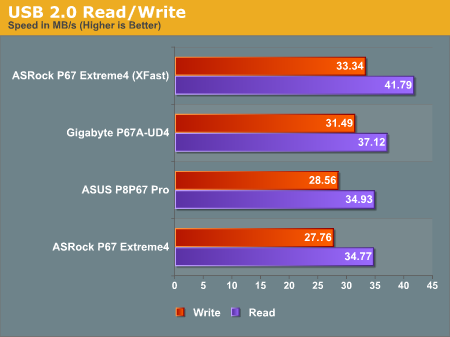
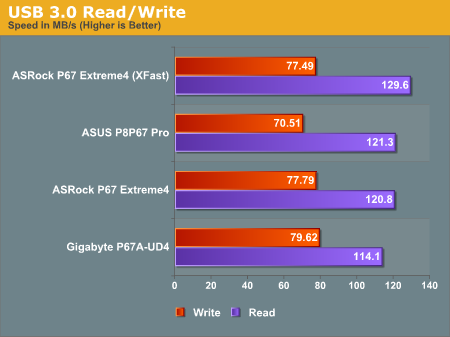

We also tested the ASRock XFast USB software. While making a slight difference to the sequential read/write speeds, it actually makes a difference in real-world situations where large amounts of small files need to be copied. USB 3.0 didn't benefit as much as USB 2.0, and it's worth noting that without XFast the USB 2.0 speed was the slowest of the three motherboards, but it does provide a benefit and turns the Extreme4 into the fastest overall USB choice.
3D Movement Algorithm Test
This benchmark is actually one I have written. My full time job involves computational chemistry, so this first benchmark uses various algorithms for three-dimensional simulation and movement of independent particles. The algorithms either employ uniform random number generation or normal distribution random number generation (with periods exceeding 2^120), and vary in various amounts of trigonometric operations, conditional statements, generation and rejection, fused operations, etc. The benchmark runs through six algorithms for a specified number of particles and steps, and calculates the speed of each algorithm, then sums them all for a final score. This is an example of a real world situation that a computational scientist may find themselves in, rather than a pure synthetic benchmark. The benchmark is also parallel between particles simulated, and we test the single thread performance as well as the multi-threaded performance.

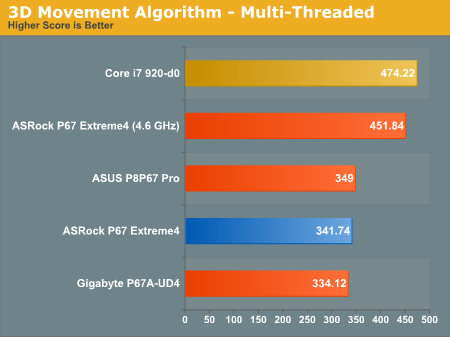
As expected, the single thread performance with the Sandy Bridge processor over the i7-920. This is in part due to the difference in speed in single-thread mode, but also to the increased logic on the Sandy Bridge processor. In the multi-threaded test, it's a case of available threads - the i5-2500K has 4 cores/4 threads available, whereas the i7-920 has 4 cores/8 threads available. In both tests, the ASRock performs well, being beaten (just) by the P8P67 Pro.
With 64-bit WinRAR, we compress a set of 2867 files across 320 folders—95% of these files are small typical website files, and the rest (90% of the size) are the videos used in the Sorenson Squeeze test. Total size is 1.52GB. WinRAR x64 3.93 attempts to use multithreading when possible.
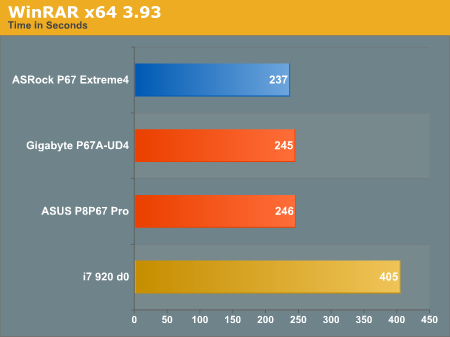
FastStone Image Viewer 4.2
FastStone Image Viewer is a free piece of software I have been using for quite a few years now. It allows quick viewing of flat images, as well as resizing, changing color depth, adding simple text or simple filters. It also has a bulk image conversion tool, which we use here. The software currently operates only in single-threaded mode, which should change in later versions of the software. For this test, we convert a series of 170 files, of various resolutions, dimensions and types (of a total size of 163MB), all to the .gif format of 640x480 dimensions.
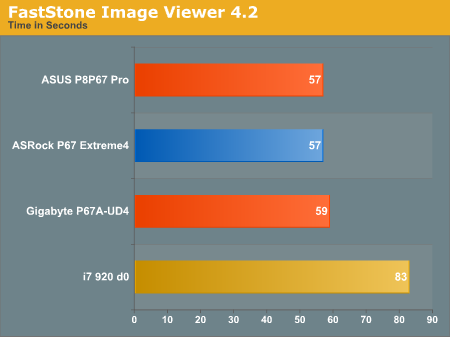
Sorenson Squeeze 6.0
Sorenson Squeeze is a professional video encoder, complete and rife with options. For this test, we convert 33 HD videos, each a minute long and approximately 42 MB in size, to WMV 512KBps format. Squeeze can encode multiple videos at once, one for each thread.
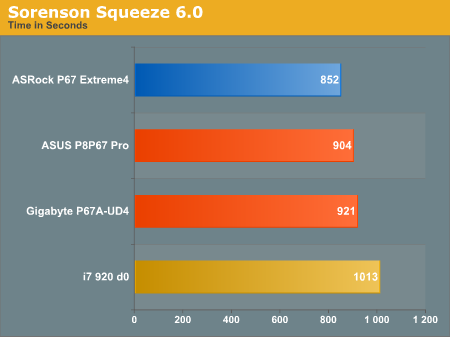
Overview
The ASRock board has relatively mediocre USB speeds, until XFast is used. In general, this board does fairly well across the entire 2D benchmark suite, either being at the top or near the top.










55 Comments
View All Comments
chrnochime - Monday, January 3, 2011 - link
So basically for any CPU that has its multiplier locked, there's just no way to oc the CPU. Either pay up for an unlocked CPU or be content with stock speed. Hmm...wolfman3k5 - Monday, January 3, 2011 - link
I've read all the Sandy Bridge articles that you guys posted. And while at first glance it seems that you're really enthusiastic about the products, they are low end and mid range products. What I take from all the Sandy Bridge articles is that X58 high end platform is obsolete and that everyone should jump on the mediocre Sandy Bridge bandwagon. When I'm saying mediocre I'm not referring to the Core i5 2500K or to the Core i7 2600K CPUs. I'm referring to the rest of the platform and its limitations. No full support for SATA 6.0 (which AMD already had for months), only two 8X PCI-E lanes for high end SLI or CrossFire configurations, only dual channel memory. I mean, it is obvious that this is a new product and that Intel needs to sell it, but it doesn't mean that everyone who got a high end system on a X58 platform should throw it away. Also, the old X58 platform is far more modular. Yes, I know that X58 is old, and I hope that we'll see an update in the high end segment.But the question is: Do you guys ever get tired of advertising for Intel, or is the money just too good?
extide - Monday, January 3, 2011 - link
If you actually read all the articles like you said, you would see that they said that if you already have a high end x58/i7 system, then you should keep it. If you are considering BUYING a new system then they suggest getting SB over a p55 or x58 system.wolfman3k5 - Monday, January 3, 2011 - link
X58 has been around before LGA1156, and is still around. Sandy Bridge is meant to kill everything that runs on LGA1156, not X58. The platform that Sandy Bridge runs on will be obsolete in 6 months. PCI-E 3.0 is just around the corner. That's when LGA2011 will be released, the successor of LGA1366. Conclusion: It doesn't really matter if you buy X58/i7 or P67/SandyBridge, they'll be both obsolete.AssBall - Monday, January 3, 2011 - link
So you must never buy anything new, because in 6 months it will be obsolete. Just because there are new platforms doesn't mean the old ones are useless or no longer cost effective.I don't see where you get that "advertising for intel" junk from, either.
vol7ron - Monday, January 3, 2011 - link
Wolfman, if you read any of Anandtech's articles, you'd know they don't accept compensation for any of their reviews - while this has helped them out sometimes, it has also hurt them. They have to be careful to be non-biased, but also respectful of manufacturers. Downing a product too much means they won't get as many products to test in the future (and have to wait longer to buy it for the review), not being honest enough discredits the article in the reader's eyes - the fine line must be walked and words chosen delicately. Still, funding is from advertisement and donations.Your AMD points are valid, but still unimpressive in comparison. As they stated, AMD is a better option for the lower CPUs, since you can OC them, whereas Intel has locked the i3's.
I agree, USB3 needs adoption, they've had long enough. That said, Intel is still in domination and AMD has some work to do if they want to contend.
DanNeely - Monday, January 3, 2011 - link
The point of the reviews is that unless you need something that is only available on x58 (ie enough PCIe lanes for 3/4GPU setups, or 2 GPUs and a high end raid card) then there's next to no point in buying into the platform because a $300 2600k, is able to beat a $1000 hexcore in most benchmarks.I'm interested in LGA2011 too because a 30% faster quad core isn't overly exciting as an upgrade. My main concern is that with the 2600K running $300, that intel might demand $500+ for a hexcore that doesn't have crippled OC limits.
Etern205 - Monday, January 3, 2011 - link
The only people interested in PCIe 3.0 are the gamers and enthusiast. 99% of the average use won't give a thought about what they have and test shows PCIe 2.0 doesn't have that much of a improvement over PCIe 1.1 in terms of performance.LGA 2011 the successor to LGA 1366 is still call Sandy Bridge. Funny how your not interested in this "obsolete" hardware but excited about the one after which by your terms is still "obsolete". This is the first time I've seen a person excited about some outdated hardware which has yet gone out the door.
As for AMD, if they made a CPU that can out perform Intel, I'm sure this site and all other will be all over it like a celebrity meet with lights and flashes. Unfortunately, the last time AMD has that spot light was before Intel came up with the Conroe.
Hopefully, AMD's bulldozer will let them once again shine in the spot light.
tim851 - Tuesday, January 4, 2011 - link
99% of the average users are still happy with the Athlon X2s they bought in 2005...mapesdhs - Wednesday, January 5, 2011 - link
That's a good summary, unless of course one prefers to dabble with 'traditional'
overclocking and/or overall platform costs of P55/X58 are more attractive. There
are plenty of very well priced P55 boards available now. Hard to give a concrete
nod to SB without knowing the mbd costs.
Personally, my results reinforce your summary. Performance-wise, SB offers
nothing useful over what I already have. Different though perhaps for someone
who is running with an i3/i5 on a P55 board, but yet again it depends on the
application.
Ian.
PS. I've praising Asrock's PCIE slot spacing for months, very glad to see
they're sticking to it. Their P55 boards use the same setup. Perfect for
cooling SLI/CF setups and a lot better than most X58 boards.